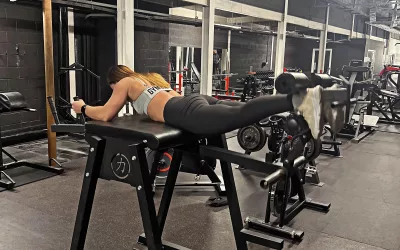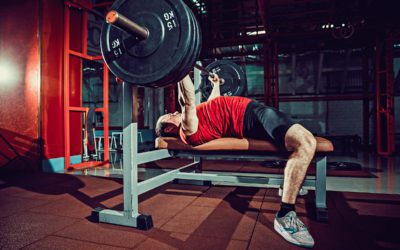The Benefits of Bodyweight Training
TOPIC: Exercise guides
While fancy new gym equipment and trendy fitness classes come grand go, we’ll always have a tool that we can exercise with at any time and in any place: Our own bodies.
Improve Your Strength & Body Awareness Without Using Weights
Bodyweight training — aka calisthenics, or strength training exercises that don’t require free weights or machines — is essential to a well-rounded fitness routine. Using our own body’s weight to stay in shape is nothing new. World class gymnasts and competitive athletes around the world use bodyweight training to get really good at moving through space.
Some people may be skeptical of a workout that uses no expensive machines or heavy weights, but bodyweight workouts improve strength, endurance, and power, and can burn through major calories. Read on for some convincing reasons to incorporate bodyweight exercises into your workout routine.
Six Bodyweight Training Benefits
There are many benefits to bodyweight training. Let’s take a look at the top six!
Convenient
Adding weight to a workout has benefits. But using your own bodyweight trumps dumbbells and barbells for convenience. With your own two hands and feet (and everything in between), you can accomplish a sweaty and effective workout anywhere–your living room, a hotel room, or outdoors in a minimal space. Some bodyweight workouts can be intensified with an on-hand prop, such as a chair, but it’s not a necessity.
Inexpensive
Although bodyweight moves can be performed at a gym, all you really need is your own body. At-home workouts also mean fewer social distractions.
Efficient
With no dumbbells, kettlebells, or barbells in the way, transitioning from one move to the next takes little time. With less rest, your heart rate maintains its elevated level, an important factor for calorie burn. Bodyweight workouts are essentially interval training, meaning alternating bursts of intense activity with periods of no- or low-intensity activity. This has been shown to be more efficient than steady-state cardio.
Customizable
Exercise machines are limited in range of use by their settings, but bodyweight exercises have a multitude of modifications for any fitness level. Take the push-up: varieties range from knees-on-the ground all the way to clap and handstand push-ups.
Multifaceted
There’s a reason the squat and push-up are recommended exercise: Both are compound movements, meaning they engage multiple joints and work more than one muscle group at a time.
Challenging
One of the most important benefits of bodyweight exercise is its ability to improve your cardiovascular endurance and muscle strength all at once. Frequently changing your position keeps the heart rate elevated, while body weight and gravity work together to strengthen muscles. One small study showed just one bout of 10 sets of 10 squat-jumps produced beneficial change in muscle fibers.
Bodyweight Exercises to Replace Machines & Dumbbells
Your gym’s collection of exercise machines is designed to target each and every muscle group. But while free weight and bodyweight exercise require balance and stability, most machines force the body to move weight on a stable, single plane. This type of movement can be unnatural and taxing on the joints. Machines can also have a more limited range of motion when compared to non-machine work, so you may not get as much out of each rep.
Bodyweight exercises focus on the body’s natural movements–pushing and pulling–and have fewer limitations to that range of motion. There are dozens of bodyweight moves that can replace your favorite gym equipment, but here are a few of our favorites.
Replace the Leg Press With a Single-Leg Squat
Also known as the pistol squat, this move is super challenging even without added weight.
HOW TO
Stand with arms extended out in front for balance. Extend one leg toward the front wall (as straight as feels comfortable) and slowly squat down with the standing leg. Keep the back straight and try not to let the knee of the standing leg pass the toes. Raise the body back to standing. To make the move easier, try a few reps gently resting a hand on the back of a chair, or place a chair behind you and just barely tap the butt on the edge between each rep.
See this blog post for a detailed look at the pistol squat!
Replace the Seated Chest Press with Push Ups
This replacement engages the whole body in the push-up, not just the chest muscles.
HOW TO
Start in the plank position with the hands below the shoulders, just outside the chest. Slowly lower the body downward until the chest just barely touches the floor—the lower the better. Keep the elbows close to the body, the back flat (the butt shouldn’t spike up toward the ceiling and the lower back shouldn’t dip toward the floor). Press the body back up to the start position; focus on driving through the hands and keep the core engaged. Make push-ups more challenging by adding a clap between reps, lifting one leg at a time, or placing the toes on a higher surface (like a chair, coffee table, or bench).
Replace Tricep Push-Downs with Bench Dips
Triceps are an often forgotten arm muscle, so they need attention. While the tricep push-down machine can feel pretty awkward and unnatural, dips are a customizable move that will have you feeling the burn after only a few reps.
HOW TO
A variation of the tricep dip can be performed on the ground by bending and extending the elbows. But for an increased range of motion, use an elevated surface such as a stable chair, table, or windowsill. Start by sitting on the edge of a chair, heels of the hands resting on the front edge. Slide the butt off the seat, holding up the bodyweight with the hands. Slowly lower the butt straight toward the floor while simultaneously bending the arms. Keep the elbows tucked in (not bowed out). For beginners, the knees can remain at a 90-degree angle throughout the move. Play with foot positioning: move the feet out, extend the legs, or try lifting one leg at a time. Whichever version you stick with, make sure to keep the back close to the chair and nearly parallel with the chair’s legs.
Replace Assisted Pull Up Machines with Standard Pull Ups
The assisted pull-up machine is a great way to ease into a more challenging pull-up. While this move requires equipment, a pull-up bar can be fairly inexpensive and well worth the investment. It enables you to complete a multitude of pull-up and chin-up variations that target different muscle groups in the arms, back, and abs.
HOW TO
Grip the bar with palms facing away from you, arms straight. Squeeze the shoulder blades back and down. With control, pull the body up toward the bar (for beginners, using a little momentum is okay) until the chin just passes the top of the bar. Squeeze the glutes at the top of the move, then slowly lower back down to the start position. Beginners can start pull-up training with a chair for assistance. Place the chair below the bar and rest the toes on the edge of the seat. Gradually place the chair further away from the bar, so the legs have to extend to reach it, until you can complete a pull-up or two without that extra stability.
Optional Equipment to Amp Up Your Bodyweight Routine
Adding extra gear can produce a more challenging and effective bodyweight workout. By elevating parts of the legs or hanging from a bar, the body has to work harder against gravity or resistance to press and pull through a greater range of motion.
Chair
Great for dips, decline push-ups, Bulgarian split squats, assisted pull-ups, beginner pistol-squats
Wall
Great for wall-sits, wall push-ups, assisted handstand push-ups
PULL-UP BAR
Great for pull-ups, chin-ups, hanging leg lifts, hanging side crunches
SUSPENSION STRAPS
Great for inverted rows, suspended plank, suspended chest presses, suspended lunges
PLAYGROUND
Great for monkey-bar pull-ups, bench dips, bench step-ups, swing rows
Final Thoughts
Bodyweight exercises focus on the body’s natural movements like pushing and pulling. You can do them basically anywhere, with almost no equipment necessary. There are dozens of bodyweight moves that can replace your favorite gym equipment.
We challenge you to try these and find more to add into your training routine every week. Start getting really good at bodyweight movements and watch your fitness gains skyrocket!
Find Your Perfect Training Plan
Sometimes all you need to reach your destination on your fitness journey is an expert guide. Look no further, we've got you covered. Browse from thousands of programs for any goal and every type of athlete.
Try any programming subscription FREE for 7 days!
Related Articles
You May Also Like...
The Ultimate Guide to Lunges: Queen of all Glute Exercises
Your glutes are the largest muscle group in your body. They’re responsible for almost everything your legs do—walking, running, jumping, squatting, lunging, and just standing upright. As far as moving through space goes, strong glutes are the bedrock of overall...
What’s a Reverse Hyper & Why Should You Use It?
Have you seen people on that weird machine, kicking back with both legs like some kind of superhero donkey?? The reverse hyperextension is actually an extremely useful movement for building posterior chain strength, and it pays to understand it.Written Byfred ormerod...
The Best Bench Press Warm Up Strategy
We get it. You’re pressed for time in the gym. But skipping the warm up is the surest way to underperform and risk injury. This 3D approach to your bench press warm up not only allows you to lift more weight, but also ensures the long-term health of your shoulder...
The Ultimate Guide to Lunges: Queen of all Glute Exercises
Your glutes are the largest muscle group in your body. They’re responsible for almost everything your legs do—walking, running, jumping, squatting, lunging, and just standing upright. As far as moving through space goes, strong glutes are the bedrock of overall...
What’s a Reverse Hyper & Why Should You Use It?
Have you seen people on that weird machine, kicking back with both legs like some kind of superhero donkey?? The reverse hyperextension is actually an extremely useful movement for building posterior chain strength, and it pays to understand it.Written Byfred ormerod...

Want more training content?
Subscribe
For Coaches
For Athletes
About
Support
Training Lab
Access the latest articles, reviews, and case studies from the top strength and conditioning minds in the TH Training Lab!
Made with love, sweat, protein isolate and hard work in Denver, CO
© 2024 TrainHeroic, Inc. All rights reserved.





